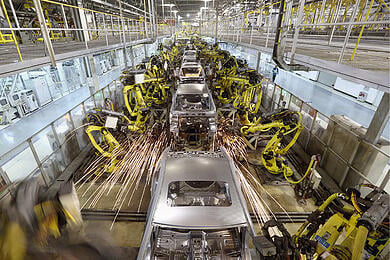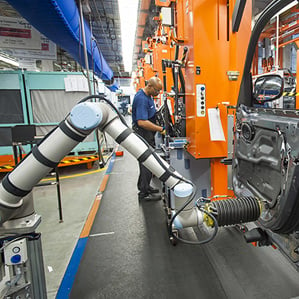Top 5 Robotic Applications in the Automotive Industry

Posted on Feb 04, 2014 in Robotics
4 min read time
For many years the automotive industry has been well known for its intensive use of industrial robotics. Since the implantation of the first industrial robots in the 1960s, a lot of things have changed. These days, the production lines need to be more efficient, flexible and precise. Many enhancements have been made on production lines over the last few years to help workers in their daily tasks. We took a look at the latest robotic applications in automotive manufacturing and here are the top 5 applications that grabbed our attention.
1) Robotic Vision
During the production of the 2013 Ford Escape, the company decided to introduce a robotic arm with "eyes". The laser and camera placed in an array on the robot wrist, are able to see exactly where to install the parts on the car body. By giving instant feedback to the robot; the windshields, door panels and fenders can be applied more precisely. The big innovation of this technology is that industrial robots are now able to put a proper offset on the installation of a part. Therefore, if there is any variation in the production, the robot can adapt its installation procedure to fit the part perfectly. This application reduces the gap between the assembled parts, which means a significant reduction in noise caused by wind.
“The ability of the machines to register any difference in each vehicle on the line improves our quality by providing a custom-like build.” - Ford engineer, Thomas Burns
2) Collaborative Robots
Although recent exposure of robot collaboration mostly concern human-robot collaboration, this case deals with more of a robot-robot collaboration. In fact, in the Chinese automotive plant, Great Wall Motors (GWM), the welding line is considered to be one of the most productive lines ever made. When 27 ABB robots work at 30 different workstations, collaboration happens between handling robots and welding robots. The ABB IRB 7600 precisely places the panel at the right location, while an ABB IRB 6640 performs the welding operations. This robotic line performs more than 4,000 welding operations on the car body in an 86 second cycle time, including the transferring operations.

3) Robotic Hand
Although the automotive industry uses a large number of industrial robots in a production line, human workers contribute to the final completion of the cars. In fact, as most of the manufacturing operations are done by industrial robotic arms, the assembly tasks are still handmade. Wiring and operations, such as wheel installation, remain a human task. To reduce the weight applied on the human hand, Equipois developed a bionic hand called the X-Ar arm. This exoskeleton device has been used by GMC for several years to reduce the stress produced by repetitive movement. This technology gives a supplementary 10 pounds of gripping force to the worker. The "gripper" comes with sensors, actuators and simulated nerves, muscles and tendons that not only reduce fatigue, but also increase manual dexterity.

4) Collaborative Robotics Part 2
As collaborative robotics becomes more and more efficient and easy to use, the automotive industry tends to use them more frequently. Getting the hard/dirty job all day long can not only be exhausting for a human worker, but it can also cause injuries and motivation to drop dramatically. This is one of the reasons why BMW has introduced collaborative robots to its assembly line. These human-friendly robots perform the final assembly of the car doors. The robots work with a door sealant that keeps sound and water out of the car. The goal of this implantation is not to replace human workers, but to help them in their daily tasks. Introducing these new robots right beside workers is now safe and if it can also help enhance productivity, it is also value added.

5) Robotic Painting
The process of painting a car body with industrial robotic arms isn’t new, but it is still an important application to highlight. In fact, since highly qualified painters are hard to find these days and considering the size of a car, it is much easier for a company to use robots for this application. In addition, painting is a very complex process, it’s hard work and toxic, as well as needing consistent results throughout the whole production. Another great aspect of using a painting robot is the reduction of waste material. Since the robots are equipped with a flowmeter, the exact same amount of paint is distributed on each part.
These are only of few of the robotic applications that are being used in the automotive industry. Several projects are being put into action to enhance productivity, security and reliability thereby reducing price and delivery time. There are certainly many interesting innovations coming up for this industry.








Leave a comment